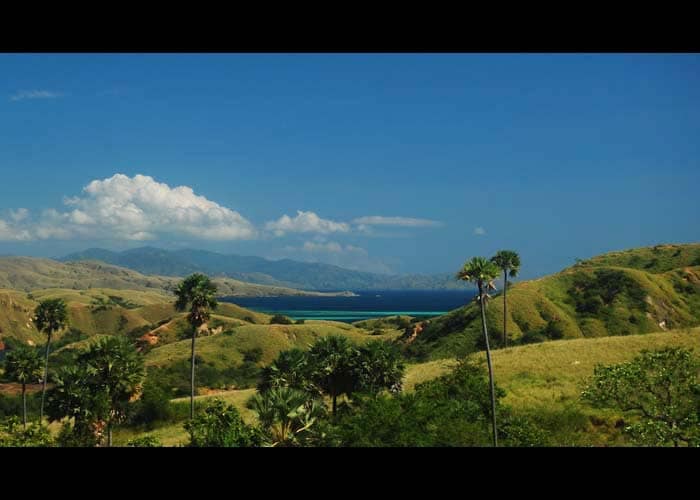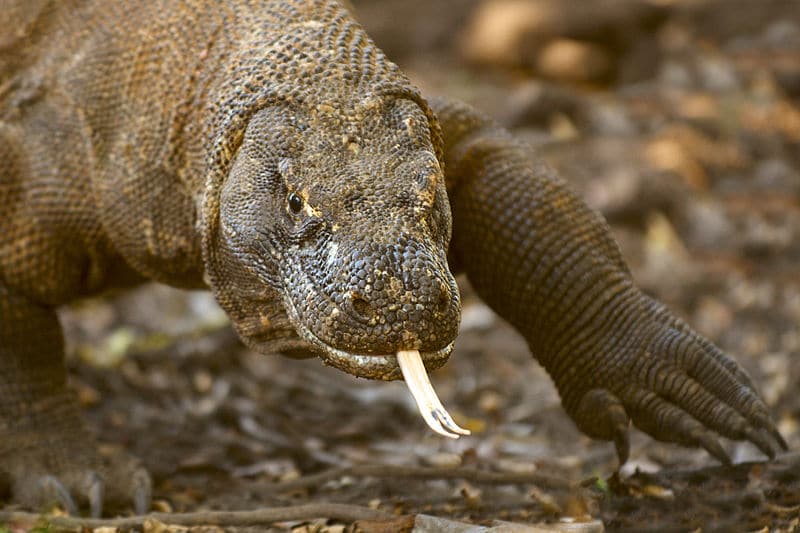A new facility dubbed ‘Jurassic Park’ is being built on Indonesia’s Rinca Island, the last remaining natural habitat of the endangered komodo dragon population. Rinca Island is one of three large islands that currently make up the Komodo National Park, along with Komodo and Padar, as well as 26 other remaining small islands- making up 1 817km of land in total. The facility (currently under construction) is designed to boost tourism to Komodo National Park but locals and activists are concerned that the new facility will negatively affect the island’s natural environment, disturb the komodo dragons’ highly acute senses and disrupt their overall interaction.
—
Komodos are the world’s largest lizards and their venomous bites can be fatal to humans. A construction worker has already been attacked by a komodo. A photo of two construction workers on top of a truck, nervously evading a komodo staring at them from below, has gone viral.
Further, Greg Afioma, a local activist at Sunspirit for Justice and Peace, says that construction would change the habitat significantly: “This kind of massive development disturbs the interaction of the animals. It will change their habitat.”
Komodos are dominant predators that can reach 8ft from head to tail and weigh up to 330 pounds and have lived in Indonesia’s Lesser Sunda Islands for millions of years. Fossil evidence found in Australia, traces the species’ existence to over four million years. Komodos have venom glands between their teeth which they use to debilitate prey.
You might also like: 503 New Species Were Identified in 2020

Rinca Island, Indonesia, the last natural remaining habitats of komodo dragons (Source: Flickr).
Komodos eat almost anything, from rodents to water buffalos. Their bite releases toxins and induces shock in its victims. There are currently 5 700 komodos left in the wild, with just over 1 000 of these on Rinca island according to data from 2018.
Commonly referred to by locals as a ‘land crocodile’, Komodo villagers are aware of the tremendous power of the species but choose to co-exist with them regardless. Komodo’s acute sense of smell is their main method of detecting prey, and they are able to use their fork-shaped tongue to examine the air and then press their tongue to the roof of their mouth, acting as a chemical analyser to identify prey via airborne molecules.
The construction of the new park involves creating a y-shaped dock resembling the komodo’s tongue, as well as a large circular concrete platform built with an elevated dock for a panoramic view of the island, spanning 1.3 hectares overall. Tourists will be charged a total of $1,000 to visit the island as part of a membership scheme, which will now be the only way tourist can visit the Island. A video released by architect Fania Hafila shows the plan for the facility, which sparked further outrage from former Komodo National Park ranger and local tour operator, Aloysius Suhartim Karya, who is concerned about the future of the park: “Jurassic Park, really? This is a mistake. I really don’t understand what the government is thinking. This island is a diamond of Indonesia. It’s beautiful as it is – real and pure – not because of super-premium amenities. Now, they want to turn it into a zoo.” A concerned local resident, Venansius Harianto, shares his view on the lasting impact the facility would have on Rinca Island: “This is a conservation area – that is the basis of our objection…you can see the heavy equipment and vehicles, tearing the place down, ruining the nature. We want the government not to close their eyes and ears. It is obvious that the construction will have a bad ecological impact.”
The facility is considered to be ecocide (human activity which directly damages ecosystems) to activists who fear the fumes and scent from the cafe being built will scramble the Komodo’s far-reaching sense of smell which ranges for many miles. “It’s safe for people. But it’s not safe for the animals,” Karya says. Indonesian activist group Save Komodo Now has also expressed their opposition: “This is the first time Komodos are hearing the roar of engines and the smell of smoke. What will the future impact of these projects be? Does anyone still care about conservation?”
The Indonesian government has emphasised that efforts have been made to mitigate tampering with nature on the island as well as ensuring the komodos remain undisturbed. Kita Awang Nistyantara, Head of Komodo National Park, says, “The construction is being done very carefully – we haven’t even cut down a single tree. We always go with the workers to make sure the wildlife are not disturbed.” Coordinating Maritime Affairs and Investment Minister Luhut Pandjaitan held a discussion on the construction of the facility, stating the development is well underway : “The project is run by the government, not the private sector. We want an integrated system that allows tourists to view the komodo dragons in a sophisticated manner. The environmental permit issued on September 4th 2020 has taken into account the impact of the construction on the natural habitat and behavior of the Komodo dragon. The development is limited to the land-use area (to function only as a viewing point to view the komodos). We’ve always been careful to comply with the park’s spatial planning protocols. Construction has reached 30% completion.” The government says that boosting tourism is the major factor for the construction, however discussing additional conservation efforts for the species was not at the forefront of the agenda for this project.
Inung Wiratno from the Ministry of Environment and Forestry: “We want to go into the premium, world-class tourism category. The komodo dragon is like the panda – highly respected – and this is the only location in the world that has them. We are not damaging anything, we are improving the facilities and visitor management.” He also claims that “no komodo dragons will become victims.”
The Komodo National Park was declared a UNESCO world-heritage site in 1991. The Paris-based organisation has said that they have reminded the indonesian governments of their obligations to protect the site, stating that it has: “requested information from the Government of Indonesia concerning these new development plans and has reminded them of the need for impact assessments to be submitted before plans are taken forward.” But the Indonesian government disputes the idea that they did not give an early period of notice before construction commenced: “We already sent a letter to UNESCO; we told them that we will build. The documents for environmental observation were already fulfilled and we considered the sensitivity of the area. UNESCO in Paris has not given an answer yet – but we did tell them.”
The construction on Rinca Island is to be discussed at this year’s UNESCO World Heritage Meeting in June, but the development is scheduled to be completed by then. Umbu Wulang Tanaamahu Paranggi, director of the Indonesian Forum for the Environment (WAHLI) has stated concerns about the potential for groundwater contamination and disruption to biodiversity: “Komodos need to be the main priority. They need to be protected in a designated area. What’s going on now is a destruction of the komodo dragons’ living spaces.” Chairman of the Research Centre for Climate Change at the University of Indonesia, Jatna Supriatna, has also spoken out on the issue of the plans to drill wells on the island and the need for reassessment: “When it comes to [the debate of using] concrete or not, I would say the materials have to be adjusted to the nature of the island.”
Featured image by: Wikimedia Commons

















